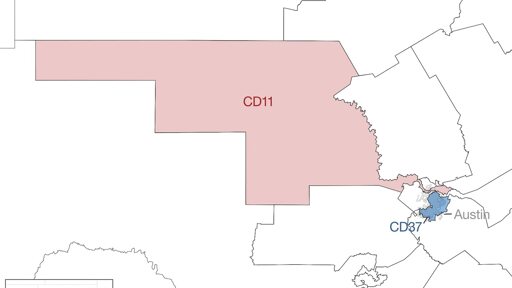As Texas Republicans try to muscle a rare mid-decade redistricting bill through the Legislature to help Republicans gain seats in Congress – at President Donald Trump’s request – residents in Austin, the state capital, could find themselves sharing a district with rural Texans more than 300 miles away.
The proposed map chops up Central Texas’ 37th Congressional District, which is currently represented by Democrat Rep. Lloyd Doggett, will be consumed by four neighboring districts, three of which Republicans now hold.
One of those portions of the Austin-area district was drawn to be part of the 11th District that Republican Rep. August Pfluger represents, which stretches into rural Ector County, about 20 miles away from the New Mexico border.



Physical landmarks like rivers and mountains would be best, but even county lines would be good.
why have districts at all?
Assigning a politician who is accountable to a specific group of people is important. The people can petition one person with requests.
In the Netherlands we have proportional representation, everyone’s vote is equal, you can vote for more than two parties, the votes are divvied out to fill an amount of seats in a parliament, that parliament needs to create coalitions that enact laws from 51% of the seats.
Gerrymandering is not normal and is illegal in most more functioning democracies.
Local representation is valuable. In the Netherlands it is practically automatic since it is only 41,850 km^2. My state is 134,771 km^2 so you’d need to split it into about 4 pieces/districts to get as local representation. Oddly enough we get 4 congressional districts: https://bdistricting.com/2020/AR/ but we still have issues with Gerrymandering has the largely R government applies cracking approaches to any D voting localities.
Texas is much larger, with more population density variance, so the problems are magnified.
I do agree that instead of a lot of small, geographically compact districts, proportional representation in a larger, but still compact multi-member district is preferable, but that’s not quite the problem we are having with districts.
Local representation is still possible with proportional voting, when voting I get an A2 paper with all the possible people sorted per party per rank of importance
I can choose to vote for my local politician, if their party doesn’t get enough votes to get my voted person in, it gets counted to the person above them in the party rank
That doesn’t sound like local representation to me. And, honestly, I’d like parties to have less influence on our elections, not more, but I guess that’s a pipe dream.
What happens if you prefer a local politician that is an independent / has no permanent party affiliation? Bernie Sanders and Joseph Lieberman have held federal office without a party affiliation.
Most single issue politicians create a party and with the people they’re working with, Bernie is not doing everything on his own.
There are tones of politicians from a local region in different parties.
To be clear we have 15 parties in government atm.
Not to mention local government (per municipality) is elected the same way
Proportional representation would require ranked choice voting, which is another reform the US sorely needs. If the US had ranked choice voting then each state could be its own district and you would find the candidate that most resonates with your values. Then township seats would be used for local representation. State legislature could also be ranked similarly to National elections.
This is the only sensible way to do it. Arbitrarily-drawn districts are silly, proportional representation serves all those needs but far better.
I get that. Makes me think though … that’s what states and counties are for. Then again my state is smaller than some counties in other states!
Ranked choice voting and proportional representation in National and state government, then townships are the local representation. Even then voters could rank councilors and petition as their ideology aligns.